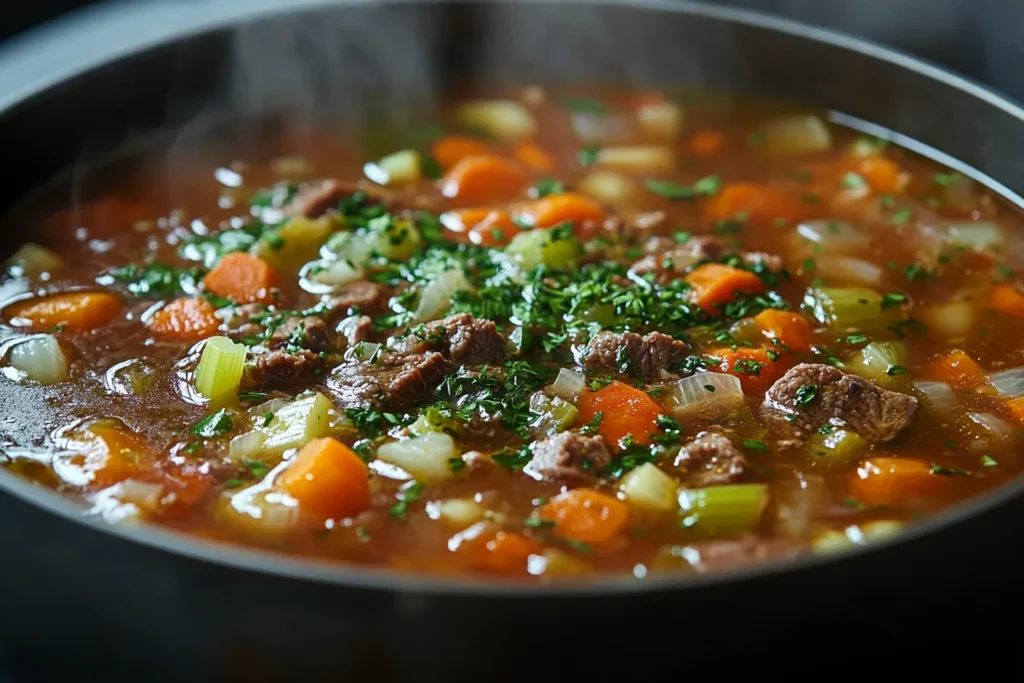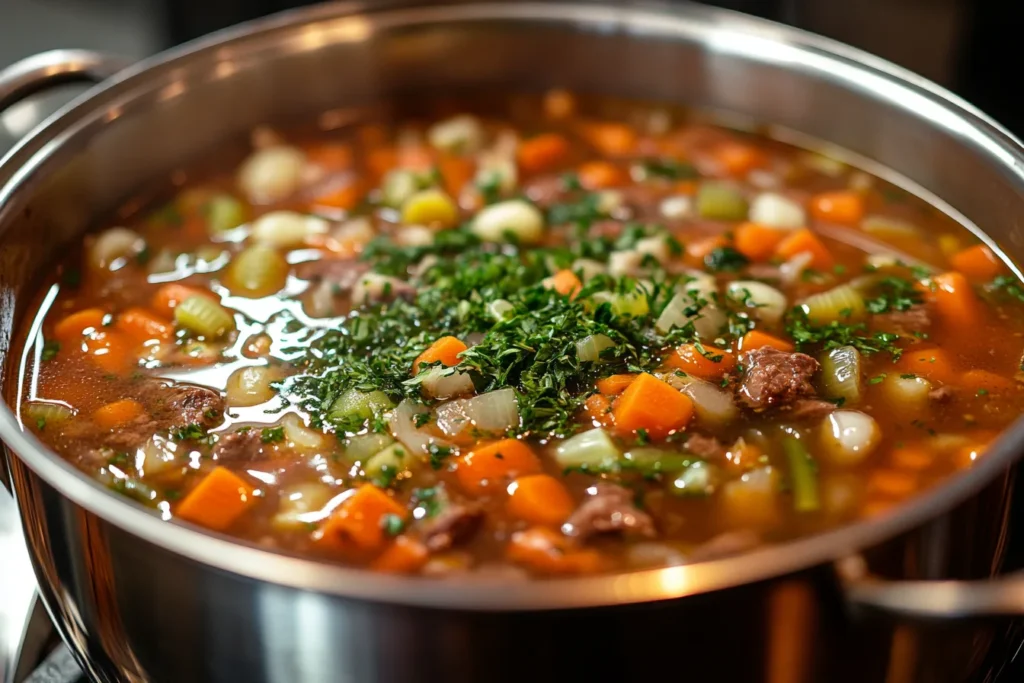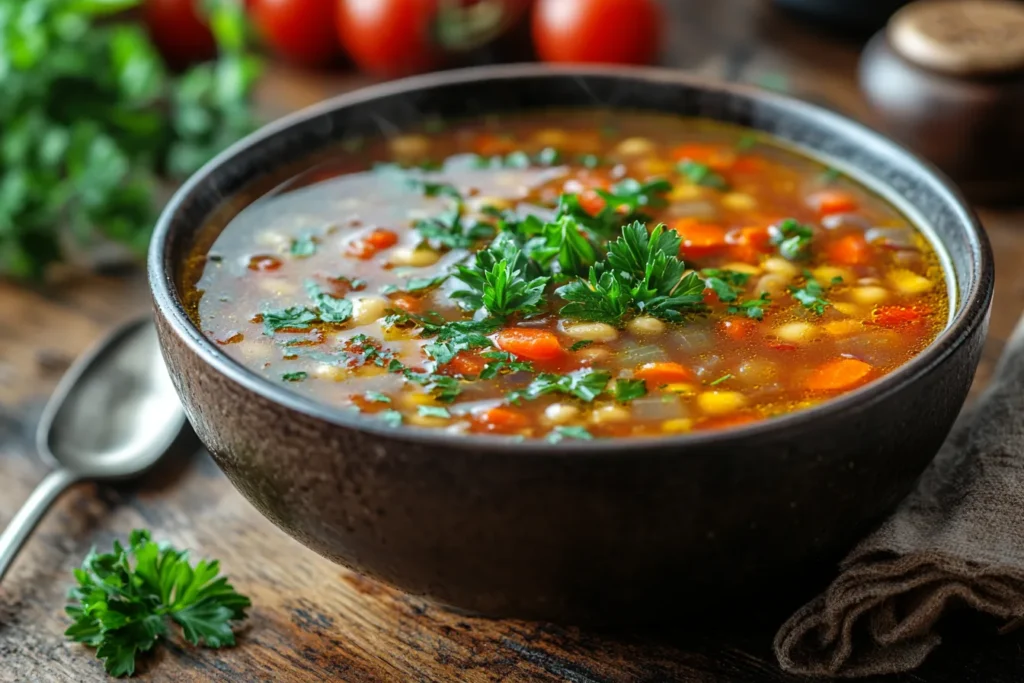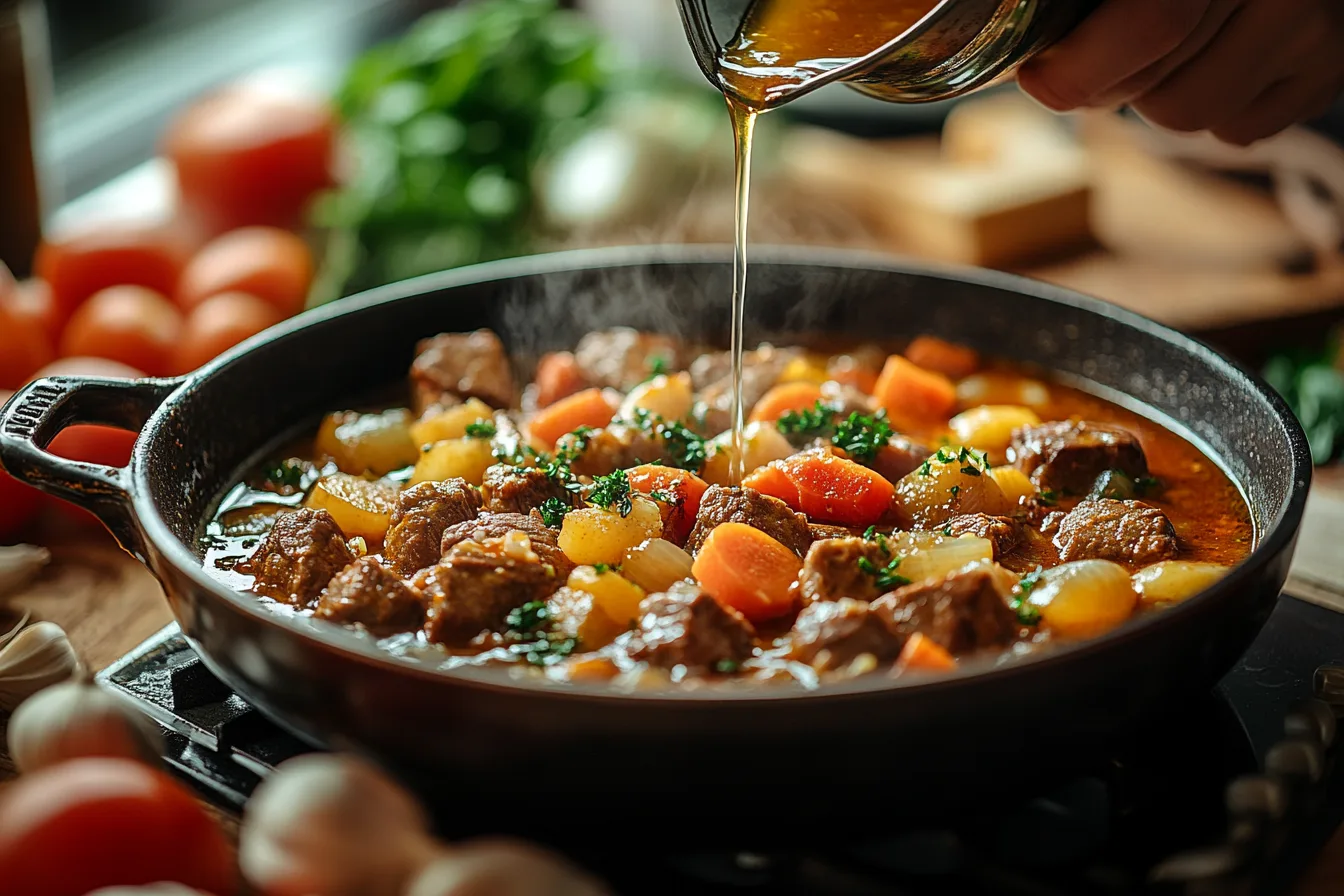Can I Use Beef Bouillon Instead of Beef Broth?.Absolutely, you can! If you’ve ever been halfway through a recipe and realized you’re fresh out of beef broth, don’t panic beef bouillon can save the day. Bouillon is like the pantry MVP that’s always there when you need it. Whether it’s in cube, powder, or paste form, it packs a punch of beefy flavor that works perfectly as a broth substitute. If you’re looking for ways to bring more flavor to your dishes, try adding bouillon to recipes like our Creole Butter Turkey Breast Recipe or even in a Beef Bouillon Powder for Brisket Recipe. You’ll find that it can elevate (without the overused word!) any meal you’re preparing.
The best part? It’s super easy to use. All you need is water and the bouillon, and voilà you’ve got yourself a quick and flavorful broth. But, there are a few things to keep in mind to make sure it works just right for your dish. Let’s break it down!

Table of Contents
What is Beef Broth?
Beef broth is a savory liquid made by simmering beef, bones, and vegetables like onions, carrots, and celery in water. It’s flavored with seasonings like garlic, bay leaves, and peppercorns, creating a rich, hearty base for soups, stews, and sauces. This slow-cooking process extracts flavors from the ingredients, giving the broth its deep, meaty taste.
Homemade beef broth is often made with roasted bones for extra depth, but you can also find it pre-packaged in cartons or cans for convenience. The store-bought versions are handy, but they sometimes include added salt and preservatives, so it’s good to check the label if you’re watching your sodium intake.
Beef broth isn’t just about taste it’s also packed with nutrients like collagen (when made with bones), protein, and minerals that come from the long simmering process. It’s versatile enough to work as a base for hearty meals or even sipped on its own for a comforting drink.
Whether you’re whipping up a family-favorite chili or adding depth to a quick stir-fry sauce, beef broth is a kitchen staple that brings bold, comforting flavors to the table. It’s simple, satisfying, and makes just about everything taste better!
What is Beef Bouillon?
Beef bouillon is a concentrated flavoring used to make beef-flavored broth. It typically comes in small cubes, granules, or paste, making it a convenient pantry staple. Bouillon is essentially a shortcut to getting that rich beefy taste without the need for simmering bones and vegetables for hours.
The cubes or granules are made by dehydrating beef stock or broth and blending it with salt, seasonings, and sometimes a bit of fat or preservatives to enhance flavor and shelf life. Paste bouillon is more moist and concentrated, offering a slightly fresher flavor than its dry counterparts.
To use beef bouillon, you simply dissolve it in hot water usually one cube or a teaspoon of granules per cup of water. This quick broth is perfect for recipes that call for beef stock, adding depth to soups, stews, sauces, and even rice dishes.
While beef bouillon is convenient, it’s often high in sodium, so it’s worth tasting as you go to avoid oversalting your dish. It’s a lifesaver when you’re out of fresh broth but still want that bold, savory kick in your cooking.
Key Differences Between Beef Broth and Beef Bouillon
While beef broth and beef bouillon bring similar flavors to your dishes, they’re not quite the same. Here’s a breakdown of the key differences:
Preparation Process
Beef Broth: Made by simmering beef, bones, and vegetables in water for hours. It’s a liquid product, often homemade or sold in cartons and cans.
Beef Bouillon: A concentrated form of beef broth, dehydrated into cubes, granules, or paste. It’s designed to be reconstituted with water for convenience.
Flavor Intensity
Beef Broth: Tends to have a milder, more natural taste with a clean, beefy flavor.
Beef Bouillon: Packs a punch with a more concentrated flavor, often with added salt and seasonings.
Ingredients
Beef Broth: Made with fresh ingredients like bones, beef, and vegetables, often without added preservatives.
Beef Bouillon: Includes flavor enhancers, salt, and sometimes preservatives to extend shelf life.
Sodium Content
Beef Broth: Typically lower in sodium (depending on the brand or if homemade).
Beef Bouillon: High in sodium, so taste your dish carefully when using it.
Convenience
Beef Broth: Requires more effort to make from scratch and takes up space in your fridge or pantry.
Beef Bouillon: Compact and shelf-stable, making it easier to store and use on short notice.
Both are useful in cooking, but the choice depends on the recipe and your flavor preferences!
When Can You Use Beef Bouillon Instead of Beef Broth?
Beef bouillon is a great stand-in for beef broth in most recipes, especially when you’re looking for convenience. Here are some common situations where you can swap it in without a problem:
Soups and Stews
If your recipe calls for beef broth as a base, dissolved beef bouillon works just as well. It adds the same hearty flavor, though you may need to adjust the salt since bouillon is often saltier.
Gravy and Sauces
Bouillon is perfect for thickening up sauces and gravies. Its concentrated flavor blends easily, and since it dissolves quickly, it saves you time without sacrificing taste.
Rice, Pasta, or Grains
Cooking grains in beef broth adds flavor, and bouillon can do the same. Just dissolve it in the boiling water before adding your rice or pasta for a delicious upgrade.
Quick Recipes
When you’re short on time, bouillon is your best friend. It’s faster than making broth from scratch or even opening a carton if you’re in a pinch.
Emergency Substitution
If you run out of beef broth mid-recipe, bouillon is the ultimate backup. Keep it in your pantry for moments like this it’s a lifesaver!
However, if a recipe needs the depth of homemade broth or you’re avoiding high-sodium ingredients, bouillon might not be the ideal choice. For most everyday recipes, though, it’s an easy and flavorful substitute.

How to Substitute Beef Bouillon for Beef Broth
Substituting beef bouillon for beef broth is super simple and doesn’t require much effort. Here’s how you can do it:
- Understand the Ratio
Most bouillon packaging will tell you the recommended ratio. Generally, it’s:
1 bouillon cube or 1 teaspoon of bouillon granules dissolved in 1 cup of hot water = 1 cup of beef broth.
Adjust the amount based on your recipe’s needs.
- Dissolve the Bouillon
To create your substitute, mix the bouillon with hot water until it’s completely dissolved. Stir well to avoid clumps, especially with granules or paste. - Taste Test for Saltiness
Bouillon is often saltier than regular beef broth. After mixing, taste the liquid and adjust the seasoning in your recipe accordingly. If it’s too salty, dilute it with a little more water. - Add Depth, If Needed
Bouillon delivers strong beef flavor but can lack the depth of fresh broth. Add a splash of Worcestershire sauce, soy sauce, or a pinch of dried herbs to mimic the complexity of beef broth. - Use as Directed
Once you’ve prepared the substitute, use it in your recipe just like you would beef broth. Whether it’s for soups, stews, or sauces, it’ll get the job done!
Recipes That Work Well with Beef Bouillon Substitutions
Beef bouillon is a versatile ingredient that fits perfectly into many recipes. Here are some ideas where substituting bouillon for beef broth works like a charm:
- Hearty Soups and Stews
Beef and Vegetable Soup: Use dissolved beef bouillon to create a flavorful broth base for tender veggies and chunks of beef.
Chili: Add beef bouillon for a bold, savory flavor that complements the spices perfectly. - Savory Sauces and Gravies
Beef Gravy: Replace beef broth with bouillon for a rich, smooth gravy to pour over mashed potatoes or roast beef.
Pan Sauce: After searing steak, deglaze the pan with a bouillon mixture to make an easy sauce. - Rice, Pasta, and Grain Dishes
Beef-Flavored Rice: Cook rice in bouillon for a simple but delicious side dish.
Beefy Risotto: Use bouillon as your liquid base to infuse deep flavor into creamy risotto. - Casseroles
Shepherd’s Pie: Substitute bouillon in the beef mixture for a savory, comforting casserole.
Beef Noodle Bake: Add bouillon to the sauce for extra beefy flavor in this pasta favorite. - One-Pot Dishes
Beef Stroganoff: Mix bouillon with water for a flavorful sauce base.
Slow Cooker Pot Roast: Dissolve bouillon in water and pour over the roast to infuse flavor as it cooks. - Quick Recipes
Ramen Hack: Stir beef bouillon into boiling water for a quick and tasty soup base.
Beefy Stir-Fry Sauce: Add bouillon to soy sauce and cornstarch for a simple stir-fry sauce.
Beef bouillon’s concentrated flavor makes it perfect for recipes where you want to save time without skimping on taste. Keep a jar or some cubes on hand for a quick way to boost your dishes!
Potential Downsides of Substituting Beef Bouillon
While beef bouillon is a convenient and flavorful alternative to beef broth, it does come with a few potential downsides to consider:
- Higher Sodium Content
Beef bouillon is often loaded with salt to enhance its flavor. If you’re watching your sodium intake, this can be a drawback. Taste your dish carefully and adjust other salty ingredients to avoid overpowering the meal. - Lacks Fresh Flavor
Unlike homemade or high-quality beef broth, bouillon may lack the depth and complexity of fresh ingredients like roasted bones and simmered vegetables. This can leave the dish tasting less natural. - Contains Additives
Many bouillon products include preservatives, artificial flavors, or MSG to improve shelf life and flavor. If you prefer clean, whole-food ingredients, this might not be ideal. - Possible Allergens
Some bouillon brands contain gluten, soy, or other common allergens. Always check the label if you have dietary restrictions or food allergies. - Overpowering Flavor
Bouillon’s concentrated taste can dominate a dish if you’re not careful with the amount used. Diluting it properly is key to maintaining balance in your recipe. - Texture Differences
When substituting bouillon, the texture might feel slightly different. Broth often has a subtle richness due to the fat content that bouillon lacks. Adding a small amount of butter or oil can help replicate this.
Homemade Alternatives to Beef Broth and Bouillon
If you’re out of beef broth or bouillon or prefer a fresh, homemade option there are several simple alternatives you can whip up using pantry staples. Here are some easy ideas:
- Vegetable Broth with Beef Flavors
Combine water with sautéed onions, carrots, celery, and garlic. Add a splash of soy sauce or Worcestershire sauce to mimic the umami richness of beef. Simmer for about 30 minutes, then strain for a quick broth. - Beef Bone Broth
Roast beef bones in the oven until browned, then simmer them with water, onions, carrots, celery, garlic, and seasonings like bay leaves and peppercorns. Cook on low heat for 8–12 hours. This slow-cooked broth is nutrient-packed and deeply flavorful. - Mushroom Broth
Sauté mushrooms (like shiitake or cremini) with onions and garlic, then simmer in water. The earthy, meaty flavor of mushrooms makes this an excellent vegetarian alternative to beef broth. - Water with Flavor Boosters
If you’re in a pinch, plain water can work with some added seasonings:
A splash of soy sauce or tamari for saltiness and umami.
A teaspoon of miso paste for depth.
Herbs and spices like thyme, rosemary, or smoked paprika for added complexity. - Chicken Broth with Adjustments
If you have chicken broth on hand, it can serve as a substitute. Add a touch of soy sauce, Worcestershire sauce, or a pinch of tomato paste to deepen the flavor and mimic the richness of beef broth. - Wine or Beer (Non-Alcoholic Options Work Too)
For recipes like stews or sauces, replace part of the broth with non-alcoholic wine or beer for a bold and complex flavor. Combine with water to balance the taste. - Herb-Infused Water
Simmer water with dried herbs like thyme, parsley, bay leaves, and a pinch of garlic powder. This creates a light, aromatic broth that works well in soups and sauces.

FAQs
Can I use beef bouillon instead of beef broth in any recipe?
Yes, you can substitute beef bouillon for beef broth in most recipes. Just dissolve it in water following the package instructions and adjust for saltiness.
How much beef bouillon equals 1 cup of beef broth?
Typically, 1 bouillon cube or 1 teaspoon of granules dissolved in 1 cup of hot water equals 1 cup of beef broth.
Is beef bouillon healthier than beef broth?
Not necessarily. Bouillon often contains more sodium and additives, while beef broth (especially homemade) has fewer processed ingredients and more nutrients.
Can I make my own beef broth or bouillon substitute?
Absolutely! You can simmer vegetables, herbs, and seasonings with water or use chicken broth with soy sauce or Worcestershire sauce for a quick beef flavor alternative.
Conclusion: Choosing the Right Option for Your Dish
When it involves selecting between beef broth and beef bouillon, the nice option relies upon for your recipe, alternatives, and what you have got available. Beef broth offers a natural, sparkling flavor, best for dishes in which intensity and richness are key. On the alternative hand, red meat bouillon is a handy, shelf-stable alternative that packs a punch of taste in seconds.
If you’re seeking out a balance between flavor and comfort, bouillon is a amazing backup. Just remember of its salt content material and do not forget improving it with fresh herbs or spices. For those who love home made flavors, whipping up your own broth or a quick replacement is constantly an option.
In the cease, each pork broth and bouillon convey bold, hearty flavors in your cooking. Pick what works high-quality in your dish and experience every chew!

